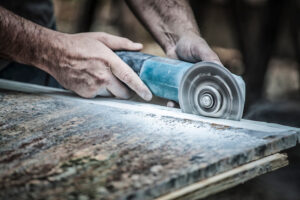Silicosis
Silicosis is a lung disease caused by inhaling crystalline silica dust. Silica can cause serious lung damage decades after exposure, especially for those who work closely with the material. If you were diagnosed with this lung disease from silica dust, contact Lung Cancer Group now. We may be able to help you access compensation for medical care and other expenses.
What Is Silicosis?
 Silicosis is an incurable lung illness that can lead to disability and, in severe cases, death. Doctors consider it a pneumoconiosis, which is a type of lung disease primarily caused by inhaling dust that leads to lung scarring.
Silicosis is an incurable lung illness that can lead to disability and, in severe cases, death. Doctors consider it a pneumoconiosis, which is a type of lung disease primarily caused by inhaling dust that leads to lung scarring.
While it is not cancerous, this disease cannot be cured and may lead to serious complications as it progresses.
Silicosis Causes
The cause of silicosis is the inhalation of silica dust. Similar to asbestos, these dust particles are microscopic and can get stuck in the lungs, resulting in lung scarring (pulmonary fibrosis), irritation, and stiffening.
- Clay
- Concrete
- Quartz
- Stone
When these materials are cut or ground, it can release silica dust into the air where it may be unknowingly inhaled.
Silicosis Symptoms
Symptoms of silicosis affect the respiratory system and may vary depending on the severity of the disease.
However, early silicosis symptoms may include:
- A cough that does not go away
- Shortness of breath
- Weakness and fatigue
As silicosis progresses, symptoms can worsen to severe chest pain, weight loss, and even respiratory failure.
Talk with your doctor if you are experiencing any of these symptoms and have a history of silica or asbestos exposure, as it could be a sign of silicosis or other serious conditions like lung cancer.
Lung Cancer Group may be able to help you find financial assistance after a silicosis diagnosis. Contact us today to see what you might be eligible for.
Who Is at Risk of Silica Dust Exposure?
A wide range of people are at increased risk of exposure to silica particles due to their jobs.
The Occupational Safety and Health Administration (OSHA) has found that 2.3 million Americans are exposed to silica at work.
- Construction workers
- Heavy equipment operators
- Plasterers or drywallers
- Stone countertop fabricators
Sadly, anyone who may be conducting renovations or performing work around silica-containing minerals may be at risk of exposure.
Tasks that put respirable crystalline silica dust in the air include:
- Breaking or grinding any silica-containing material
- Cement surfacing and paving
- Ceramics and glass manufacturing
- Demolishing buildings with high amounts of silica-based materials
- Metal casting or other foundry work
- Mineral ore-treating processes
- Quarrying (extracting stone) and stone cutting
- Sand casting or sandblasting
- Tunneling
Diagnosing Silicosis
Doctors use multiple tests to confirm a silicosis diagnosis.
- Physical examinations and discussions of silica dust exposure history
- Imaging tests such as chest X-rays and computed tomography scans (CT scans)
- Pulmonary function tests (tests that examine how the lungs are functioning)
In some cases, doctors may also conduct laboratory tests to rule out other conditions. These tests can include blood tests or biopsies to examine tissue.
Talk to your health care provider as soon as possible if you think you may have silicosis so they can begin testing.
Types of Silicosis
There are three types of silicosis: acute, chronic, and accelerated. The type of silicosis a person is diagnosed with will depend on how much silica dust they were exposed to and for how long.
The table below breaks down each type of silicosis.
| Type | Silica Exposure Level | Length of Exposure |
|---|---|---|
| Acute Silicosis | Extremely high | 5 years or less |
| Accelerated Silicosis | Moderate to high | Around 5-10 years |
| Chronic Silicosis | Low to moderate | 15-20 years |
Each type of silicosis will have variations in the severity of symptoms and treatment approaches.
Treatment Options for Silicosis

Sadly, there is no cure for silicosis since the damage done by inhaling crystalline silica dust can’t be reversed. However, treatments can improve lung function, quality of life, and life span.
There are a few potential treatments for silicosis:
- Bronchodilator medicines can make breathing easier by widening and relaxing your airways.
- Lung transplants can help people with severe silicosis by halting disease progression and improving quality of life.
- Oxygen therapy delivers highly concentrated oxygen via an air mask or tube through the nasal passage. It can reduce irritation and breathing difficulties.
- Pulmonary rehabilitation helps patients slowly strengthen the lungs through monitored exercise.
The prognosis or expected outcome for silicosis patients depends on the patient’s health, the severity of their condition, and the extent of their silica dust exposure. However, many patients may have a positive prognosis after undergoing treatment.
Patients with silicosis can often live for 10-20 years after their diagnosis. In fact, 25% of silicosis patients had a survival time beyond 33 years, according to a study published in the Journal of Huazhong University of Science and Technology.
Treatment for silicosis can be expensive. Thankfully, Lung Cancer Group may be able to help. Contact us now to learn more about the options available to you.
Complications from Silicosis
Because crystalline silica dust can remain in the body for decades, silicosis often progresses or worsens over time as scarring continues to build up in the lungs.
For this reason, many silicosis patients develop other conditions, including:
- Kidney disease: Kidneys that are weakened or damaged cannot properly filter out toxins and waste from the blood, leading to multiple other health issues.
- Lung nodule growths: Often non-cancerous, these are small lumps that form in the lungs.
- Progressive massive fibrosis: Scarring caused by silica dust can continue to spread throughout the lung and greatly limit its function.
- Pulmonary hypertension: As damage to the lungs continues, blood flow throughout the lungs can be limited, causing high blood pressure.
- Recurrent chest infections: With reduced lung function, the risk of infections like chronic bronchitis, pneumonia, and others is increased.
The Dangers of Silica Dust
Autoimmune diseases like rheumatoid arthritis, scleroderma, and lupus are also sadly common among those exposed to silica dust.
Dust particles in the lungs are usually filtered by the immune cells known as alveolar macrophages. These cells are unable to break down silica dust and begin to weaken, causing them to attack other healthy cells.
The Lupus Foundation of America reported that silica dust can increase someone’s risk of lupus by 2-5 times, making it one of the “strongest known risk factors” for the condition.
Additionally, silica can also increase someone’s risk of developing lung cancer. Approximately 230 people are diagnosed with silica-related lung cancer each year, according to Cancer Council.
Get Legal Help After a Silicosis Diagnosis
Workers who were exposed to silica dust and later developed silicosis or other serious lung conditions may be eligible to file a silicosis lawsuit.
These lawsuits seek to provide victims of silica particles with compensation to help pay for treatments and other expenses.
To start a silicosis lawsuit, you must have the following:
- Proof of silica exposure, such as a job description, eyewitness account, or other job records
- An official silicosis diagnosis
- Medical bills showing the financial burden of getting a diagnosis or treatment
A compassionate silicosis lawyer can help you through the legal process and fight for the highest settlement possible in your case.
Lung Cancer Group is connected with some of the top silicosis attorneys across the country who are committed to helping those affected by this dangerous material. Contact us today so we can help you get started with a free case review.
Silicosis FAQs
What are the first signs of silicosis?
The first signs of silicosis may include:
- Difficulty breathing
- Fatigue
- Persistent cough
Talk with your doctor as soon as possible if you are experiencing these symptoms and have a history of silica dust exposure. They can begin screening tests to look for silicosis or other serious lung diseases.
Who is most likely to get silicosis?
Some jobs may place workers at increased risk for silica dust exposure.
High-risk occupations may include:
- Construction workers, especially drywallers and plasterers
- Countertop installers
- Heavy equipment operators, such as farmers and engineers
- Stone cutters
How much exposure does it take to get silicosis?
People can develop silicosis if they are exposed to extremely high concentrations of silica dust over the course of several months or years.
However, people exposed to low to moderate concentrations of silica dust can also develop silicosis if regularly exposed to silica dust over 15 to 20 years.
How long does it take for silicosis to set in?
Silicosis usually happens after being exposed to silica for 10 to 20 years. However, it can sometimes develop after just 5 to 10 years of exposure.
Can lungs heal from silicosis damage?
Unfortunately, the lung damage from silicosis is irreversible. However, treatments like oxygen therapy, pulmonary rehabilitation, and medications can improve your quality of life and life span.

